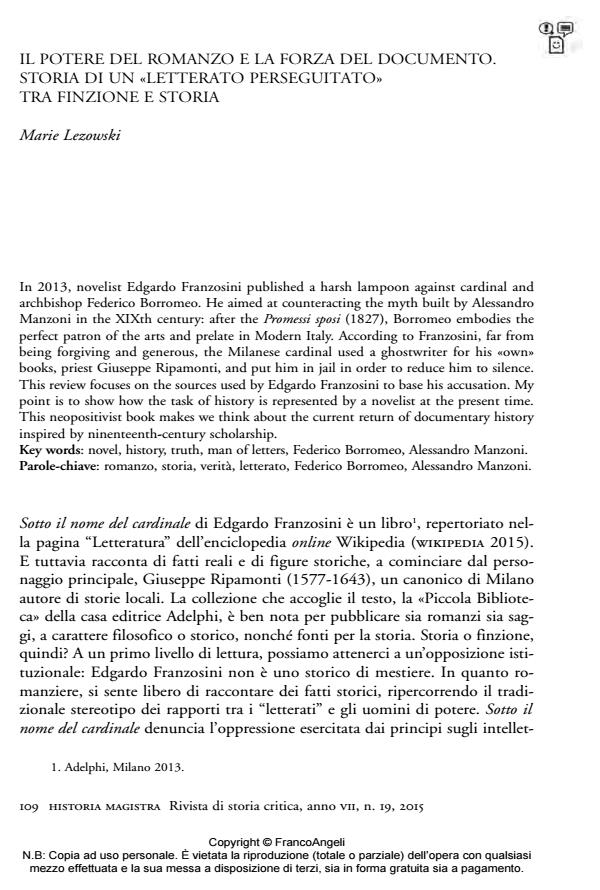Il potere del romanzo e la forza del documento. Storia di un «letterato perseguitato» tra finzione e storia
Journal title HISTORIA MAGISTRA
Author/s Marie Lezowski
Publishing Year 2016 Issue 2015/19
Language Italian Pages 9 P. 109-117 File size 88 KB
DOI 10.3280/HM2015-019012
DOI is like a bar code for intellectual property: to have more infomation
click here
Below, you can see the article first page
If you want to buy this article in PDF format, you can do it, following the instructions to buy download credits

FrancoAngeli is member of Publishers International Linking Association, Inc (PILA), a not-for-profit association which run the CrossRef service enabling links to and from online scholarly content.
In 2013, novelist Edgardo Franzosini published a harsh lampoon against cardinal and archbishop Federico Borromeo. He aimed at counteracting the myth built by Alessandro Manzoni in the XIXth century: after the Promessi sposi (1827), Borromeo embodies the perfect patron of the arts and prelate in Modern Italy. According to Franzosini, far from being forgiving and generous, the Milanese cardinal used a ghostwriter for his «own» books, priest Giuseppe Ripamonti, and put him in jail in order to reduce him to silence. This review focuses on the sources used by Edgardo Franzosini to base his accusation. My point is to show how the task of history is represented by a novelist at the present time. This neopositivist book makes we think about the current return of documentary history inspired by ninenteenth-century scholarship.
Keywords: Novel, history, truth, man of letters, Federico Borromeo, Alessandro Manzoni.
- Cusani F. (1877), Paolo Moriggia e Giuseppe Ripamonti, in «Archivio Storico Lombardo», a. 4 (1877), pp. 43-69.
- Dandolo T. (1868), Giuseppe Ripamonti, in «Rivista Contemporanea Nazionale Italiana», 55 (1868), pp. 194-206.
- Franzosini E. (1995), Raymond Isidore e la sua cattedrale, Adelphi, Milano 1995.
- Lezowski, M. (2014), Histoire et autorité épiscopale. Frédéric Borromée et les réemplois des Histoires de l’Église de Milan dans le premier XVIIe siècle, in Callard C., Crouzet-Pavan E. et Tallon A. (a cura di), La politique de l’histoire en Italie.
- Arts et pratiques du réemploi (XIVe-XVIIe siècle), Presses de l’Université de Paris-Sorbonne, Paris 2014, pp. 269-83.
- Mauri P. (2013), Alessandro Manzoni il Cardinale e l’uomo della peste, in «la Repubblica», 6 ottobre.
- Morazzoni M. (2013), Il ghostwriter del Cardinale, in «Il Sole 24 Ore», 14 luglio.
- Sciascia L. (2010) (1a ed. 1964) Morte dell’inquisitore, Adelphi, Milano.
- Tabucchi A. (1995), L’altra cattedrale di Chartres metafora della letteratura, in «Corriere della sera», 28 dicembre.
- Wikipedia 2015, Edgardo Franzosini: http://it.wikipedia.org/wiki/Edgardo_Franzosini, consultato il 16 aprile 2015.
Marie Lezowski, Il potere del romanzo e la forza del documento. Storia di un «letterato perseguitato» tra finzione e storia in "HISTORIA MAGISTRA" 19/2015, pp 109-117, DOI: 10.3280/HM2015-019012